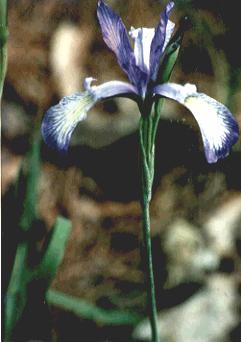![[SIGNA LOGO]](masthead.gif)
![[SIGNA LOGO]](masthead.gif)
 Part of the fun of working on the SIGNA Seed Exchange is the
three or four days in January when about twelve of us gather to sort seeds
and fill orders. The chatter around the table is invariably about irises.
One of the people who has helped every year I've been involved is Bob Gamlin,
a quiet fellow, good gardener, rock gardener and iris grower. I had never
met him before these gatherings. One day talk turned to I.
prismatica (pictured), one of my favorite species. It's been easy
for me to grow in various types of conditions, from wet to dry, full sun
to semishade. It has what many consider to be an unfortunate habit of "running".
It is not a clump former but has stoloniferous growth (though not invasive).
I have chosen to accept this interesting growth pattern and interplant prismatica
with daffodils, lilies and other kinds of bulbs and include some type of
perennial ground cover like variegated creeping euonymus or ajuga. Getting
back to Bob, he told us of a patch of I. prismatica on the corner
of a state highway in Exeter, New Hampshire. He described the sea of blue
when they are in bloom and lamented that the highway was under construction
and the plants were in danger.
Part of the fun of working on the SIGNA Seed Exchange is the
three or four days in January when about twelve of us gather to sort seeds
and fill orders. The chatter around the table is invariably about irises.
One of the people who has helped every year I've been involved is Bob Gamlin,
a quiet fellow, good gardener, rock gardener and iris grower. I had never
met him before these gatherings. One day talk turned to I.
prismatica (pictured), one of my favorite species. It's been easy
for me to grow in various types of conditions, from wet to dry, full sun
to semishade. It has what many consider to be an unfortunate habit of "running".
It is not a clump former but has stoloniferous growth (though not invasive).
I have chosen to accept this interesting growth pattern and interplant prismatica
with daffodils, lilies and other kinds of bulbs and include some type of
perennial ground cover like variegated creeping euonymus or ajuga. Getting
back to Bob, he told us of a patch of I. prismatica on the corner
of a state highway in Exeter, New Hampshire. He described the sea of blue
when they are in bloom and lamented that the highway was under construction
and the plants were in danger.
The following summer, armed with Bob's directions, Marty Schafer, Darrell Probst and I went hunting wild prismatica. I had always wanted to see what they might look like growing wild. They were just where Bob said--there was a highway, an intersection with a traffic light, and below the grade of the road there were I. prismatica growing in full sun, in very wet sandy soil together with a vigorous stoloniferous grass which grew about 12' tall, sundews, poison ivy, and the most lovely pale pink terrestrial orchids which were about 6 inches tall--sheets of them. All five of these were growing in a strip of about 50 feet between the forest and the road. On the very edge of the forest, in the wettest spots were Iris versicolor already past bloom. When I say the soil in which the prismatica were growing was sandy and wet, it was really awful soil, dense, soggy, almost airless soil, with water sitting on top in a few spots. There was already some destruction by the construction crews--large areas with big tire tracks where nothing grew anymore.
We began examining several flowers of prismatica, looking for variation. In my garden there are white, light blue, purple, maroon, and pink flowered forms gathered from many sources. I thought we might find a range of colors in this wild patch, but all the flowers were about the same--a very nice mid-blue--deeper and bluer than in any of the prismatica I was growing at home. There was considerable variation in the patterns, however. Some flowers had larger white and yellow signals, some had more veining in the signal with more or less yellow. The shapes also varied -- some had longer hafts with small or long pendant falls and some had shorter hafts creating a really nicely formed flower. The number of branches and buds varied also. There were larger and smaller flowers but it was impossible to know how much this had to do with culture and how much with genetics. Most of the plants "ran" in the typical stoloniferous way of prismatica with a very wide open 'habit--one leaf fan here and another four to six inches away. There were, however, a few that seemed more compact or clump-like.
Considering the large number of plants in this location and the fact that they all seemed in imminent danger we dug up pieces of several plants -- trying to get representatives of most of the variations. We probably took twelve different clones. I feel good about our decision to dig these plants, because when Bob came to the Seed Exchange work-day this year he told is that the entire area where the prismatica was is now paved over with blacktop.
All of the transplants were grown in pots and planted in the ground after a couple of months. All survived and we are now evaluating them. Last year was their first year of bloom so it will take some time to pick out the best ones. We are most excited about the one with the shortest stolons. Seed of these plants was offered in this years' seed exchange and you might want to look for them again next year.
Jan Sacks -- Carlisle, Ma.
Reprinted by permission from the SIGNA newsletter, number 58
| Home | Introduction | Member Info | Reading Room | Seed Exchange | Links | Photos | Mail |